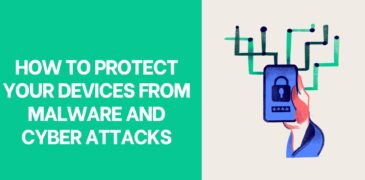Protecting your devices from malware and cyber attacks is paramount in today’s digital age. With cyber threats evolving rapidly, safeguarding your personal and sensitive information requires proactive measures and vigilance. In this guide, we’ll explore essential strategies, tools, and best practices to fortify your devices against malicious software and cyber threats. From installing antivirus software to practicing safe browsing habits and keeping your software up to date, we’ll equip you with the knowledge and resources to defend your devices effectively. By implementing these measures, you can mitigate the risk of malware infections and safeguard your digital security and privacy.
Understanding Malware and Cyber Attacks
Malware, short for malicious software, refers to any software designed to infiltrate, damage, or compromise a computer system without the user’s consent. Cyber attacks encompass a wide range of malicious activities, including malware infections, phishing scams, ransomware attacks, and more. Malware can be delivered through various vectors, such as infected email attachments, malicious websites, or compromised software.
Common types of malwares include viruses, worms, trojans, spyware, adware, and ransomware, each with its own methods of infiltration and objectives. Cyber-attacks can target individuals, businesses, governments, and critical infrastructure, leading to data breaches, financial loss, identity theft, and disruption of services. Understanding the nature of malware and cyber attacks is crucial for implementing effective cybersecurity measures. By recognizing the signs of suspicious activity, practicing caution online, and employing security solutions, individuals and organizations can mitigate the risk of malware infections and protect their devices and data from cyber threats.
Installing and Updating Antivirus Software
Installing and updating antivirus software is a fundamental step in safeguarding your devices against malware and cyber threats. Antivirus software serves as a crucial defense mechanism by detecting, blocking, and removing malicious software from your computer system. It scans files, emails, and websites for known malware signatures and behaviors, providing real-time protection against various types of cyber attacks.
Regularly updating antivirus software ensures that it remains effective against emerging threats and vulnerabilities. Updates often include patches for newly discovered security flaws, improvements to malware detection algorithms, and database updates to detect the latest malware strains. Additionally, antivirus software may offer additional features such as firewall protection, web browsing security, and email filtering to enhance overall device security.
Practicing Safe Browsing Habits
Practicing safe browsing habits is essential for protecting yourself from online threats such as malware, phishing scams, and identity theft. Start by only visiting trustworthy websites and verifying the legitimacy of URLs before clicking on them. Avoid clicking on suspicious links or pop-up ads, as they may lead to malicious websites or initiate downloads of harmful software.
Additionally, be cautious when downloading files or software from the internet, and only download from reputable sources. Always keep your browser and security software up to date to ensure they can detect and block the latest threats effectively. Consider using privacy-enhancing browser extensions and enabling features such as phishing protection and safe browsing mode. Finally, educate yourself about common online scams and phishing techniques to recognize and avoid potential threats proactively.
Securing Your Network with Firewalls and Encryption
Securing your network with firewalls and encryption is essential for protecting your data and devices from unauthorized access and cyber threats. Firewalls act as a barrier between your internal network and external threats, filtering incoming and outgoing traffic based on predefined security rules. They monitor and block suspicious or malicious traffic, preventing unauthorized access to your network and devices.
Encryption adds an additional layer of security by encoding data transmitted over the network. Making it unreadable to unauthorized users. This ensures that even if intercepted, the data remains protected from eavesdropping and tampering. Secure protocols like HTTPS encrypt web traffic, while VPNs encrypt all data transmitted between your device and the VPN server, ensuring privacy and security.
Keeping Software and Operating Systems Up to Date
Keeping software and operating systems up to date is crucial for maintaining the security and integrity of your devices. Software updates often include patches and fixes for security vulnerabilities discovered by developers or reported by users. These vulnerabilities could be exploited by cyber attackers to gain unauthorized access to your system, install malware, or steal sensitive information.
Updating your software and operating systems ensures that you have the latest security protections in place to defend against evolving cyber threats. Enable automatic updates whenever possible to streamline the process and ensure timely installation of security patches. Additionally, regularly check for updates for third-party software and applications installed on your devices. As they may also contain security vulnerabilities that need to be addressed.
Using Strong and Unique Passwords
Using strong and unique passwords is essential for protecting your online accounts from unauthorized access and cyber threats. Strong passwords are complex and difficult to guess. Typically comprising a combination of uppercase and lowercase letters, numbers, and special characters. Avoid using easily guessable passwords such as “password” or “123456” and refrain from using common words or phrases.
Using a unique password for each online account prevents a single compromised password from jeopardizing your other accounts. Consider using a reputable password manager to generate and store complex passwords securely. Password managers can also help you manage and organize your passwords across multiple accounts, reducing the temptation to reuse passwords.
Being Wary of Suspicious Emails and Attachments
Being wary of suspicious emails and attachments is essential for protecting yourself from phishing scams, malware infections, and other cyber threats. Cybercriminals often use phishing emails to trick recipients into divulging sensitive information. Clicking on malicious links, or downloading infected attachments.
To avoid falling victim to phishing attacks, carefully scrutinize emails for red flags. Such as unexpected requests for personal information, urgent demands, or grammatical errors. Be cautious when clicking on links or downloading attachments from unknown senders. As they may lead to malicious websites or initiate malware downloads. When in doubt, verify the legitimacy of the email by contacting the sender directly using a trusted communication channel.
Implementing Multi-factor Authentication
mplementing multi-factor authentication (MFA) adds an extra layer of security to your accounts by requiring more than just a password for access. Typically, MFA involves combining something you know (like a password) with something you have (like a smartphone or security token) or something you are (like a fingerprint or facial recognition).
By requiring multiple forms of authentication, MFA makes it significantly more difficult for unauthorized users to access your accounts. Even if they have obtained your password through phishing or other means. This helps protect your sensitive information and reduces the risk of unauthorized access, identity theft, and fraud. Many online services and platforms offer MFA as an option, and it’s highly recommended to enable it wherever possible.
Backing Up Your Data
Regularly backing up your data is crucial for safeguarding against data loss due to hardware failure, cyber attacks, or accidental deletion. By maintaining up-to-date backups of your important files and documents. You can restore your data quickly and minimize the impact of unexpected incidents.
Implement a comprehensive backup strategy that includes regular backups of all critical data. Including documents, photos, and important files. Choose reliable backup solutions such as cloud storage, external hard drives, or network-attached storage (NAS) devices. And ensure that backups are performed automatically and regularly.
Educating Yourself and Others about Cybersecurity Best Practices
Educating yourself and others about cybersecurity best practices is essential for building a strong defense against cyber threats. Stay informed about the latest security trends, threats, and vulnerabilities through reputable sources such as cybersecurity blogs, news outlets, and industry reports.
Share your knowledge and expertise with family, friends, and colleagues to help them understand the importance of cybersecurity and empower them to adopt safe online practices. Educate them about the risks of phishing scams, malware infections, and data breaches, and provide guidance on how to protect their devices and personal information.
Conclusion
In conclusion, safeguarding your devices from malware and cyber attacks requires a proactive approach and adherence to best practices. By installing antivirus software, practicing safe browsing habits, securing your network with firewalls and encryption, keeping software updated, using strong passwords, being cautious of suspicious emails, implementing multi-factor authentication, regularly backing up data, and promoting cybersecurity awareness, you can mitigate the risk of cyber threats and protect your digital security and privacy.
Also Read:







